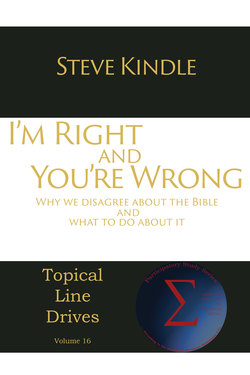Читать книгу I'm Right and You're Wrong - Steve Kindle - Страница 5
На сайте Литреса книга снята с продажи.
ОглавлениеIntroduction
How many times have you had a conversation with someone that involved a disagreement over the Bible? And how many times have these conversations led to interruptions of friendships or even extended family disputes? Some of these disputes have split congregations. Even the more mild disagreements can leave us perplexed. Why is it that something so plain to one is so obviously unconvincing to others? This often leads us to search for ways to convince others through honing our interpretive skills, doing elaborate word studies, consulting scholarly commentaries and the like. In the end, however, people don’t easily change their minds, and we are left to wonder why.
This book differs from most in that rather than looking at how to interpret the Bible properly, we’ll examine the sources of disagreement among interpreters. We all have our own ways of trying to understand the Bible and they are close to our hearts. Many of us think our way is superior to most, if not all. But we will not venture into who is right and who is wrong in our interpretations. What concerns us here is why we interpret the way we do and what our attitude should be toward those with whom we disagree.
The current landscape of biblical disagreement is literally worldwide. After nearly two millennia of serious-minded interpreters diligently studying the Bible, we are in alarming disarray. This would not be so serious except for the reality that differences of interpretation can run so deep that, in the extreme, Christians have killed other Christians1, and less so, many denominational bodies have separated, even condemned to hell, those with whom they disagree. Nothing demonstrates this more than the 33,000 Christian denominations identified in the World Christian Encyclopedia (2001, 2nd edition). While not all of these separated themselves out of theological or interpretive differences, thousands did.
1 On Boston Common, a statue stands in memory of Mary Dyer, a Quaker who refused to disavow her beliefs, and was hanged by Puritans in 1660, because it was illegal to be a Quaker in Massachusetts.
Here’s a brief listing of some of the areas with no consensus that continue to divide Christendom: original sin, mode of baptism, purpose of baptism, the Trinity, present role of the Holy Spirit, how to be saved, is there a hell, all the millennial reign issues, women’s role in the church and society, universal or limited salvation, war and pacifism, faith and works, justification, sanctification, gay issues, appropriate church polity, how to understand the Lord’s Supper (Communion, Eucharist), when to observe the Lord’s Supper, who should receive the Lord’s Supper, Apostolic succession, Theory of Evolution, interpreting the book of Revelation, the historicity of Adam and Eve, is the future open or preordained, the death penalty, abortion, euthanasia … on and on we could go. Some of these positions have divided churches, families, even nations. These are of continuing concern as we seek to live together in our churches, homes and communities.
The ways in which these issues are dealt with is the subject of this book. Every one of the positions taken to bring clarity to these issues is not made in a vacuum; they all arise out of the prevailing conditions of the day and are products of influences we are not always aware of. That is as true for me as it is for you. So let’s take a look at the highlights of the history of interpretation, or what could be called a history of disagreement.
